Top Rankings
Berea Independent School District ranks among the top 20% of public school district in Kentucky for:
Category
Attribute
Student Attention
Lowest student:teacher ratio (Top 1%)
For the 2025 school year, there is 1 public preschool serving 467 students in Berea Independent School District. This district's average pre testing ranking is 2/10, which is in the bottom 50% of public pre schools in Kentucky.
Public Preschool in Berea Independent School District have an average math proficiency score of 21% (versus the Kentucky public pre school average of 39%), and reading proficiency score of 35% (versus the 47% statewide average).
Minority enrollment is 15% of the student body (majority Black), which is less than the Kentucky public preschool average of 24% (majority Hispanic and Black).
Overview
This School District
This State (KY)
# Schools
3 Schools
543 Schools
# Students
1,005 Students
227,023 Students
# Teachers
81 Teachers
15,378 Teachers
Student : Teacher Ratio
12:1
12:1
District Rank
Berea Independent School District, which is ranked within the bottom 50% of all 171 school districts in Kentucky (based off of combined math and reading proficiency testing data) for the 2021-2022 school year.
The school district's graduation rate of 80-84% has decreased from 95% over five school years.
Overall District Rank
#135 out of 172 school districts
(Bottom 50%)
(Bottom 50%)
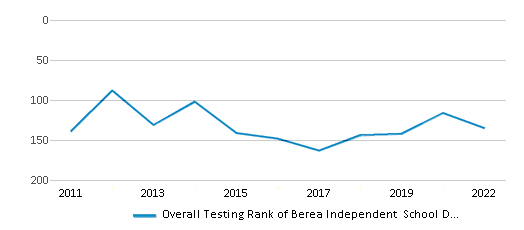
Math Test Scores (% Proficient)
28%
38%
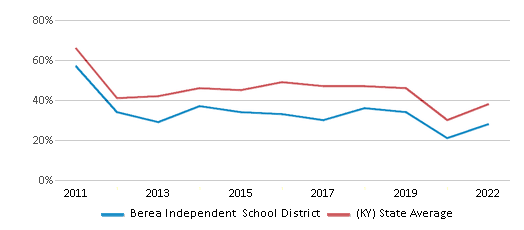
Reading/Language Arts Test Scores (% Proficient)
38%
45%
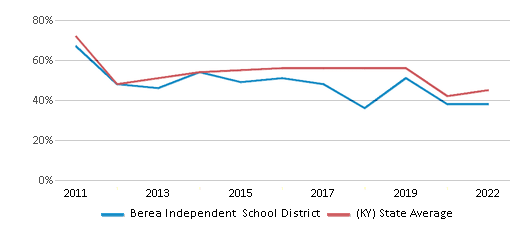
Science Test Scores (% Proficient)
16%
22%

Graduation Rate
80-84%
90%
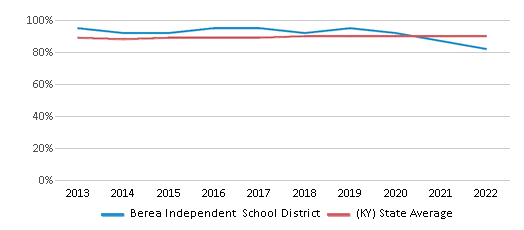
Students by Ethnicity:
Diversity Score
0.31
0.41
# American Indian Students
n/a
304 Students
% American Indian Students
n/a
n/a
# Asian Students
8 Students
4,469 Students
% Asian Students
1%
2%
# Hispanic Students
53 Students
19,502 Students
% Hispanic Students
5%
9%
# Black Students
33 Students
18,667 Students
% Black Students
3%
8%
# White Students
834 Students
171,963 Students
% White Students
83%
76%
# Hawaiian Students
4 Students
463 Students
% Hawaiian Students
1%
n/a
# Two or more races Students
73 Students
11,655 Students
% of Two or more races Students
7%
5%
Students by Grade:
# Students in PK Grade:
43
25,491
# Students in K Grade:
80
34,372
# Students in 1st Grade:
73
32,950
# Students in 2nd Grade:
73
33,468
# Students in 3rd Grade:
64
28,975
# Students in 4th Grade:
63
28,582
# Students in 5th Grade:
71
28,113
# Students in 6th Grade:
66
7,193
# Students in 7th Grade:
71
2,891
# Students in 8th Grade:
73
3,034
# Students in 9th Grade:
78
511
# Students in 10th Grade:
97
497
# Students in 11th Grade:
66
478
# Students in 12th Grade:
86
446
# Ungraded Students:
1
22
District Revenue and Spending
The revenue/student of $16,287 is higher than the state median of $14,242. The school district revenue/student has grown by 11% over four school years.
The school district's spending/student of $15,115 is higher than the state median of $13,981. The school district spending/student has grown by 11% over four school years.
Total Revenue
$16 MM
$9,360 MM
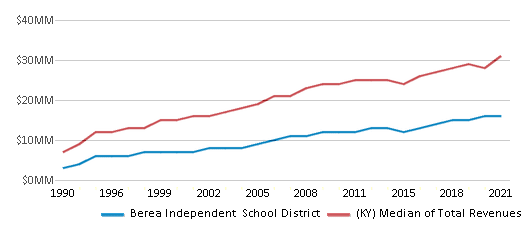
Spending
$15 MM
$9,189 MM

Revenue / Student
$16,287
$14,242

Spending / Student
$15,115
$13,981
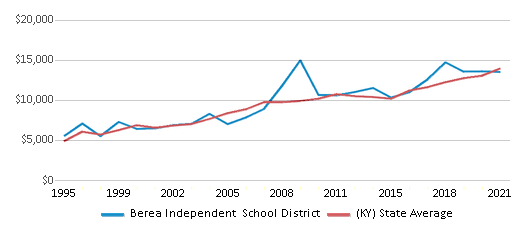
Best Berea Independent School District Public Preschools (2025)
School
(Math and Reading Proficiency)
(Math and Reading Proficiency)
Location
Grades
Students
Rank: #11.
Berea Community Elementary School
(Math: 21% | Reading: 35%)
Rank:
Rank:
2/
Bottom 50%10
2 Pirate Pkwy
Berea, KY 40403
(859) 986-4065
Berea, KY 40403
(859) 986-4065
Grades: PK-5
| 467 students
Recent Articles

Year-Round Or Traditional Schedule?
Which is more appropriate for your child? A year-round attendance schedule or traditional schedule? We look at the pros and cons.

Why You Should Encourage Your Child to Join a Sports Team
Participating in team sports has a great many benefits for children, there is no doubt. In this article you will learn what those benefits are.

White Students are Now the Minority in U.S. 九游体育s
Increasing birth rates among immigrant families from Asia and Central and South America, combined with lower birth rates among white families, means that for the first time in history, public school students in the United States are majority-minority. This shift in demographics poses difficulties for schools as they work to accommodate children of varying language abilities and socio-economic backgrounds.





